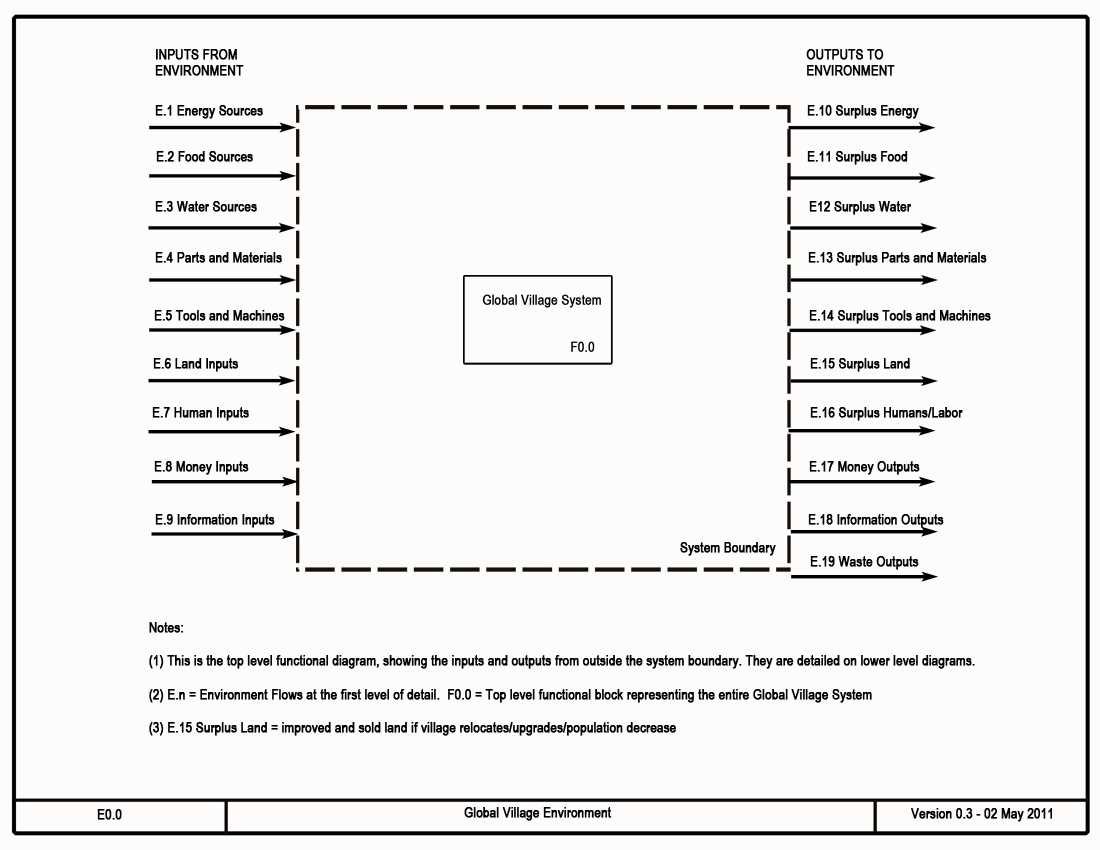Functional Block Diagram E.0 Environment
Diagram and Notes
Notes
- See diagram for notes 1-3
Description
The Global Village System is a combination of people, information, equipment, and facilities (land, buildings, etc.) which together provide for the needs of its people in a sustainable and growing, improving fashion. On this top level diagram, the entire system is represented by a single box. This is broken down into more detail on other diagrams.
Assumptions:
For the purpose of concept development and system sizing certain assumptions have to be made. When planning an actual project or product the real conditions will need to be entered into a system model to find the required features and quantities. The following general assumptions are used. More detailed ones appear on their respective block diagrams.
- Village sizes of 2, 10, 50, 250, and 1250 people, of which 45.5% are working.
- Average conditions for land geology, soil productivity, sunlight, and working hours.
- Sufficient funds are available when needed to build the system.
- The local environment can supply materials and other inputs, and accept outputs as needed.
Environment:
The system has a large number of interactions with the external environment, i.e. everything outside the system. The diagram shows the highest level of interaction as flows numbered E.1 to E.19. These break down to more detailed items on lower level diagrams:
E.1 Energy Sources includes: sunlight, wind, wave power and stream energy if available, and commercial electricity. Commercial electricity may be balanced with E.10 Surplus Energy over time if more is produced at certain times.
E.2 Food Sources includes: nutrients for humans, livestock, and plants, seeds, and new livestock. Food inputs may be balanced with E.11 Surplus Food over time if more is produced than needed
E.3 Water Sources includes: rain, streams, and public water supply. Well water is not an input from the environment, it is part of facilities.
E.4 Parts and Materials includes: premade parts and basic non-food materials including bulk rock, soil, compost, sand, wood, metal, glass, etc. It also includes consumed items such as lubricants.
E.5 Tools and Machines: Tools do not have internal power, machines do. This includes external transportation, bought tools, bought machines, and temporary use of equipment by rent, trade, or shared use.
E.6 Land Inputs includes: bought land and temporary use of land by rent, trade, or shared use.
E.7 Human Inputs includes: full time residents, part time workers, and hired contractors.
E.8 Money Inputs includes: contributed capital and sales of surplus/specialized items to others.
E.9 Information Inputs includes: OSE plans, instructions, software, and upgrades, data connections and active data flow on the connections.
Links to Related Diagrams
Higher Level: None, this is the top level
Functions: F.0 Global Village System
Inputs: (To be done)
Outputs: (To be done)
Controls: (To be done)
Mechanisms: (To be done)
